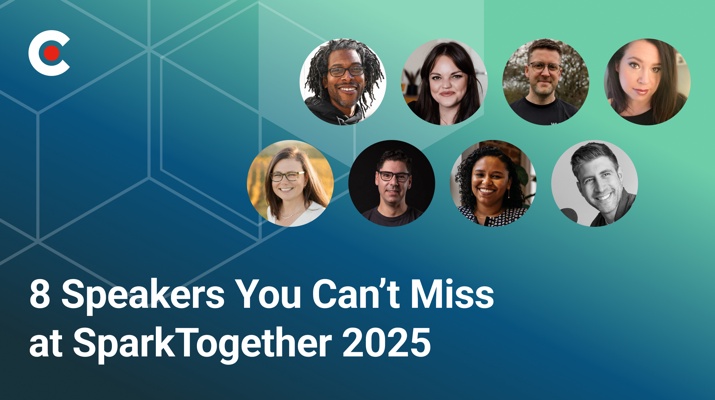

Updated April 22, 2025
Customers are clicking fewer links than ever, thanks to zero-click searches. Learn how you can adapt to this change with snippet-worthy content.
Finding information online used to take a lot of effort. You’d type a query into a search bar, click a few links, and (hopefully) track down your needs. But that’s all changed with the rise of zero-click searches.
Now, platforms aim to answer your query on SERPs. Ask Google for “Italian restaurants near me,” and a list of places appears at the top with photos and reviews.
Looking for a Digital Marketing agency?
Compare our list of top Digital Marketing companies near you
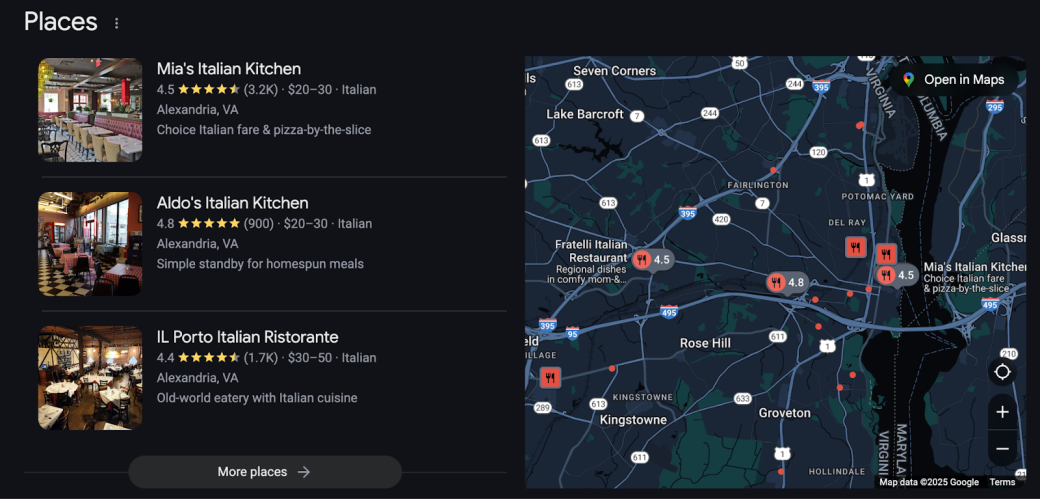
You may even see a map displaying all the nearby pasta joints. It’s faster than scouring Yelp or sifting through the local foodie’s blog.
“Zero-click marketing is the future!” says Jacqueline Basulto, CEO of SeedX. “People want quick, easy-to-digest answers and content to their questions from search engines and AI assistants.”

While these searches are convenient for users, they pose a challenge for businesses. You work hard on your content, so the thought of no one clicking it can be discouraging. But with the right strategies, zero-click marketing can attract customers, not drive them away.
In 2022, Amanda Natividad at SparkToro coined the concept of zero-click searches. She explains that they happen when platforms show “content that offers valuable, standalone insights (or simply engaging material, with no need to click).”
Every time you use Google, you encounter zero-click content.
Search for “border collie,” and you’ll see an overview from Wikipedia right on the SERP.
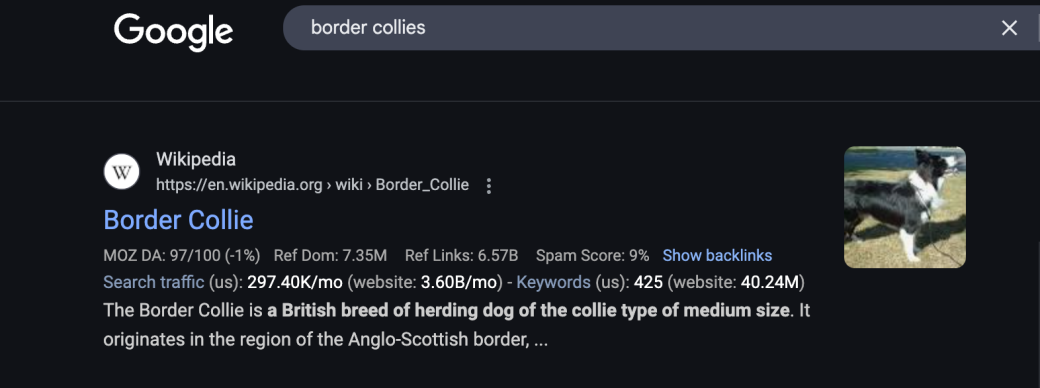
Look up “Christopher Nolan movies,” and a carousel of his films appears at the top. This content tries to answer your query without sending you to another site.
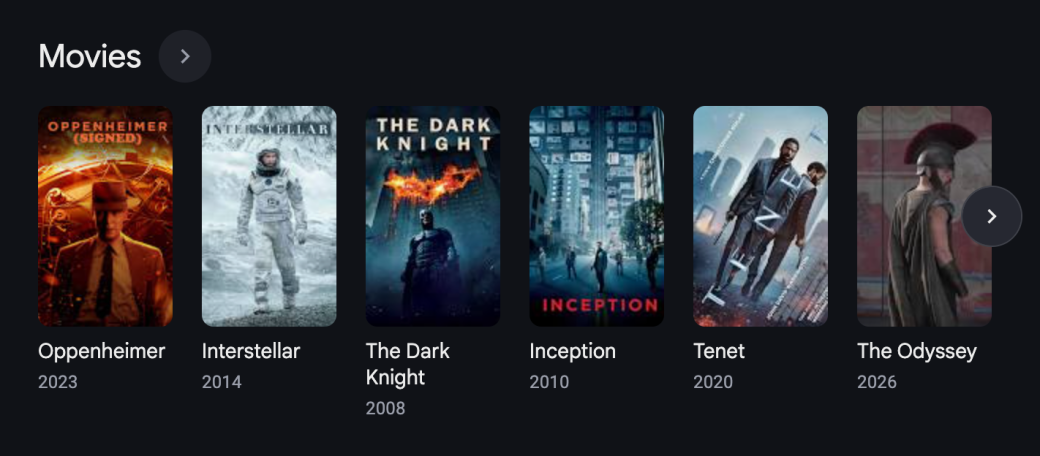
Zero-click content is all the rage on social media, too. Type something into TikTok’s search bar, and videos will auto-play as you scroll down the SERP. It’s the same story on Instagram. These sites prioritize native content so much that they don't even allow users to add links to captions.
These searches have fundamentally changed how we interact with the internet.
A Bain & Company survey found that “80% of consumers now rely on ‘zero-click’ results in at least 40% of their searches.” As a result, organic web traffic is down by an estimated 15% to 25%.
But that doesn’t have to spell doom for your business. Lutfi Aydeniz, CEO of fascinatid, explains, “Zero-click marketing is a very powerful strategy in today’s digital landscape, especially with the rise of search engines prioritizing instant answers.”
“It’s crucial for brands to deliver value directly through platforms,” Aydeniz continues, “...by optimizing content to capture attention quickly and efficiently.”
With such strategies, businesses can entice users to keep engaging with their brand.
Platforms adapt their search results based on the user’s input. For instance, the SERP for “coffee” might include nearby coffee shops and nutrition facts on Google.
But if you search for “What is the best coffee maker?”, a "People Also Ask" section appears. It’s all designed to answer your query as quickly and accurately as possible.
Optimizing your content for different searches can boost your chances of appearing in the SERPs. Here are a few common types:
Google’s featured snippets spotlight content that directly answers user queries. These extracts appear in special boxes at the top of the SERPs.
As a business owner, you can’t directly control if Google features your content — that’s up to the all-powerful algorithm. But you can make your content more snippet-able.
That’s a top priority for Jacqueline Basulto. “We’re working to make sure our clients' information is optimized to be easily accessed by Google, AI processing ChatGPT, and other crawlers,” she shares. “That way, it’s referenced first when consumers search for information.”
Boost the chances that your content will get featured by including clear definitions. If you’re writing a blog post about hiking gear, add a section titled “What are hiking poles?” Then, include a short definition right below. The next time someone types that question, Google may feature this paragraph in the search bar.
Sometimes, Google compiles information into a knowledge panel at the top or right side of the SERPs. This content appears when you search for entities, such as:
Knowledge panels aim to give a quick overview of a topic. They typically draw on multiple sources so you can get information at a glance instead of clicking on multiple websites.
Take Taylor Swift’s knowledge panel, for instance.
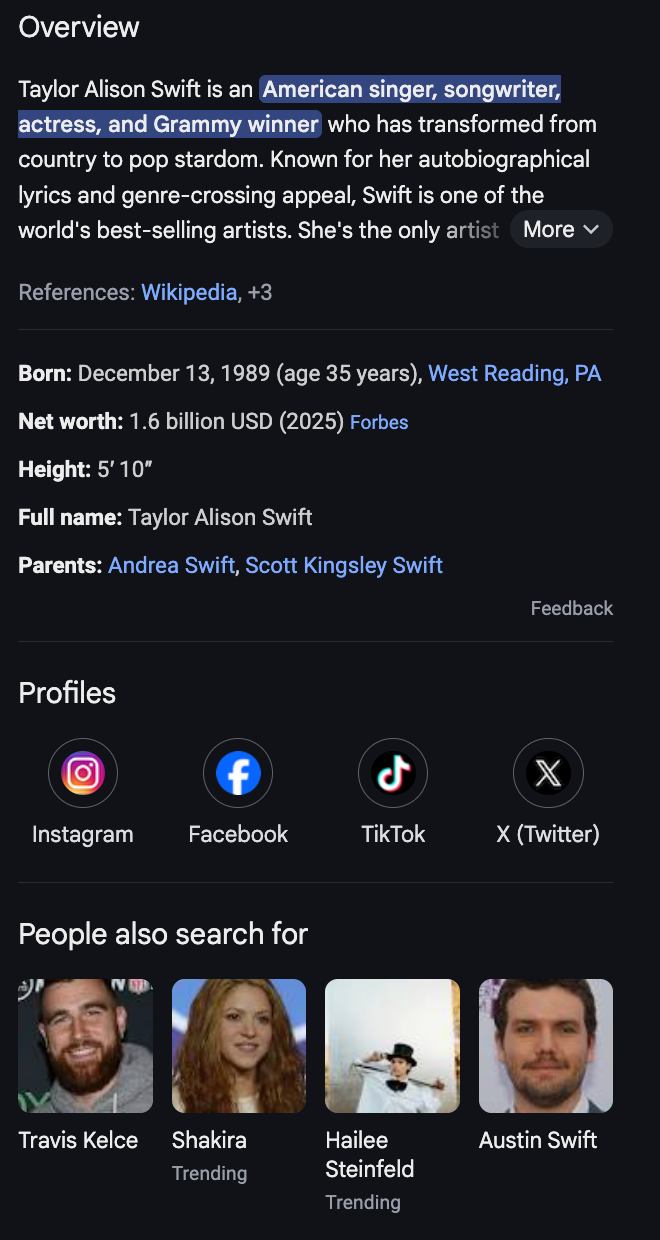
It includes a short, AI-generated paragraph with information from Wikipedia and the University of Oregon. You’ll also find quick statistics — such as Swift’s net worth and height — followed by her social media profiles. You may also see a “People Also Search For” box with other celebrities. Essentially, it’s a crash course in all things Taylor Swift.
When you search for local destinations, Google creates a pack of the top three nearby businesses. It displays key details, such as:
Typically, it’s easier to appear in a local pack than other types of zero-click searches. Thousands of websites might answer the question, “What are vintage clothes?” but a small city might only have a handful of vintage shops.
It’s natural to phrase queries as questions, especially when you’re using a voice assistant. This action automatically prompts Google to create a “People Also Ask” section. It includes relevant questions with featured snippets from various websites.
If you search for “What is search engine optimization?”, the PAA section will include questions like these:
As you may have noticed from the first question, these questions aren’t always grammatically correct. That’s because they’re based on what users enter into the search bar, either manually or through voice search.
Up to this point, most of the zero-click content we’ve discussed has been specific to Google. But image and video carousels are more universal.
This type of content displays media in cards that users can swipe through. Google generates carousels for many types of content, including:
Carousels are a staple on social media, too. Facebook uses carousels to display “people you may know” and reels. Similarly, many Instagram users create carousels to tell visual stories. This interactive content boosts engagement — after all, swiping is immersive — while keeping visitors on the platform.
Many businesses add social media snippets to their websites. This content lets visitors check out what you’re up to on other platforms without requiring them to leave your site.
“I recommend integrating social media sharing buttons, embedded feeds, and customer review widgets,” advises Arham Khan, CEO of Pixated Agency. “Sharing buttons encourage visitors to amplify your content, increasing reach and engagement.”
Khan continues, “Embedded feeds — particularly Instagram and TikTok for lifestyle brands — keep the site dynamic by showcasing fresh content and driving engagement.”
Take GoPro, for instance. The tech company’s home page features its latest Instagram posts, all featuring customers in the middle of thrilling adventures. As the header explains, this content shows “how the GoPro community captures their fun all around the world.”
This is a great example of what Khan describes as “social proof through user-generated content.” These posts, he explains, “build trust and enhance credibility, both of which I believe are essential for conversions.”
Visitors who love this embedded content may decide to buy your products — or just follow your social media accounts. Either way, you’ve got their attention with zero clicks.
Search engines often display reviews for products or businesses right in the SERPs. That way, you don’t need to wade through Yelp or seller websites to see what other customers think of them.
Zero-click marketing might seem scary, but it’s really just another kind of SEO. You can get the hang of it with a few simple tweaks.
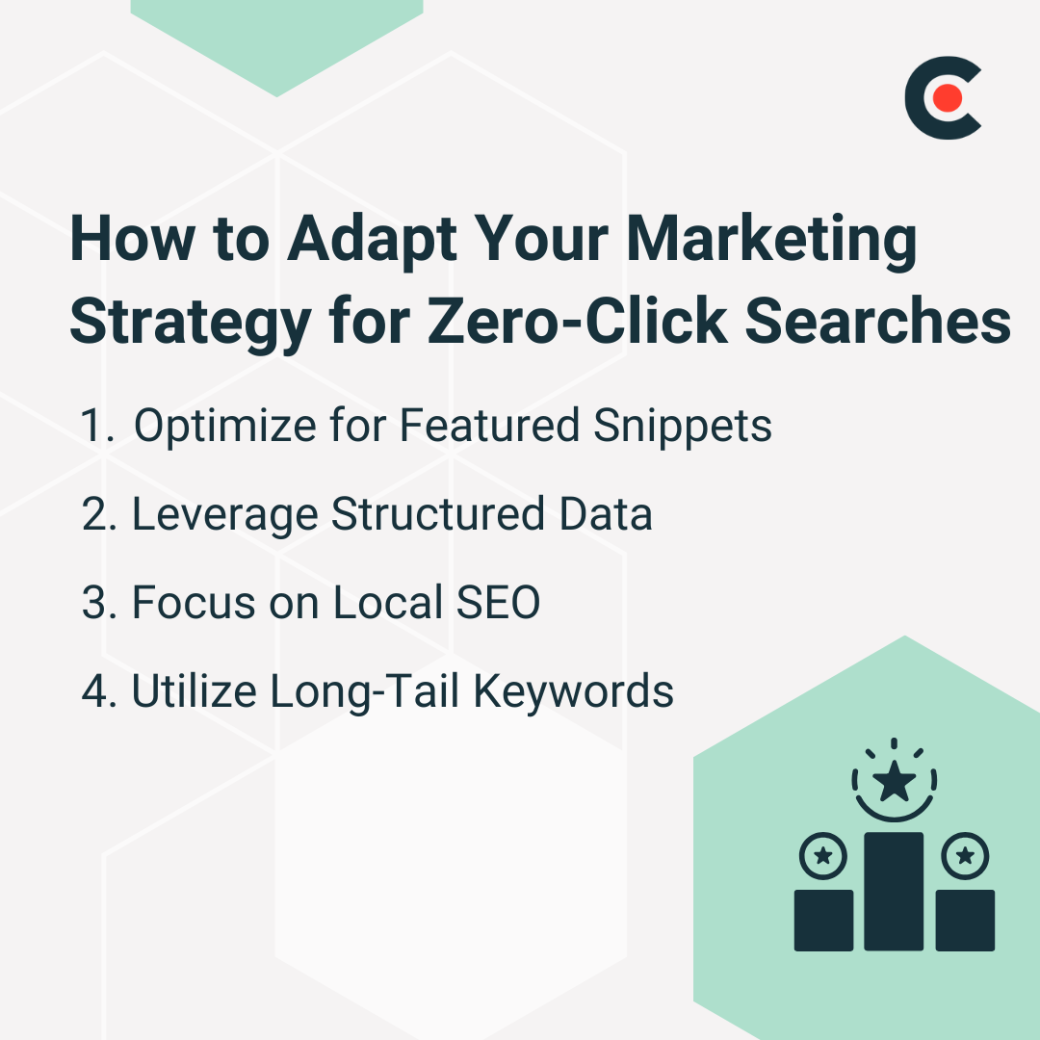
Featured snippets are one of the most coveted types of zero-click content. If Google’s algorithm picks your content, it will appear right at the top of the SERPs — with a bright pink highlight for even more attention.
Valentina Chiriacescu, Chief Commercial Officer of Ecommerce Today, recommends a customer-centric approach. “Write for humans, optimize for search engines,” she advises. “Google rewards high-quality, helpful content. Aim for blog posts and landing pages that answer real customer questions.”
Use keyword research tools to find relevant queries that you can answer in a sentence or two. Then, structure your content to fit one of Google’s snippet formats.
These excerpts are true snippets — usually no more than 40 to 50 words. Users often ask “What is X?”, so use the same format in your answer. For instance, “A pool noodle is a buoyant foam tube used by swimmers” is more likely to get snipped than “Makeshift sword, floatation device, sibling-bopper — a pool noodle is anything you can imagine.”
Google’s algorithm also loves bulleted or numbered lists. If you search for “How to pack for a hiking trip,” for instance, a list from REI’s blog appears as a featured snippet. Follow their lead by creating step-by-step guides that match your content.
Structured data tells Google how to interpret your content instead of leaving it up to the algorithm. Adding these tags to your site could boost its visibility in the SERPs, especially in rich results.
Here are just a few types of structured data:
If you run a dessert blog, you could “mark up” — or tag — your recipes with structured data. This increases the chances that Google will display your content when users look for cookie recipes. It may appear as a rich snippet with a photo and ingredient list.
As you tag your content, you can also test your structured data to ensure everything works correctly.
Top websites have already answered many broad search queries.
For example, Google uses a featured snippet from Wikipedia to answer the query, “What is a comic?” Trying to unseat an authoritative source like this can be an uphill battle.
However, local searches are usually much less competitive. That means it’s easier for users searching for products or services in a specific location to appear in the SERPs. If you own a comic book shop in Akron, there’s a good chance that your business can get featured in local packs and other zero-click content.
Optimize your business for local SEO by creating a Google Business Profile. This account lets you share your business hours, photos, and other relevant details. Google draws on this information when generating search results, so don’t leave anything blank.
Add relevant local keywords to your content, too. Your blog might include phrases like “best comic shop in Akron” and “superhero comics in Ohio.” Just don’t go overboard — no one wants to read a nonsensical word salad.
Customers often search for hyper-specific phrases that are three words or longer. For instance, someone looking for cat toys might input “green cat wand with glitter feathers.” These keywords often get less traffic than generic queries, making them easier to rank for. Sprinkling them in your content can be a highly effective zero-click marketing strategy.
Search engines aren’t going away anytime soon, but how users engage with them is changing. Customers want instant answers to simple queries, not extensive research projects. Zero-click content helps them find the information they need faster.
This content will become even more critical as more people turn to AI-powered searches. While only 13 million Americans used generative AI for online searches in 2023, Statista predicts that this figure will rise to 90 million in 2027.
Don’t get left behind. By adjusting your marketing strategies now, you can stay two steps ahead of the competition.


